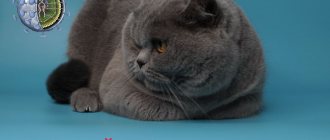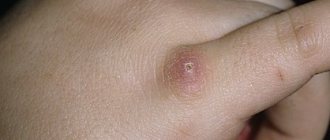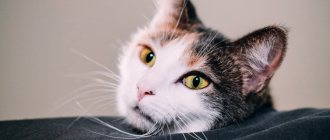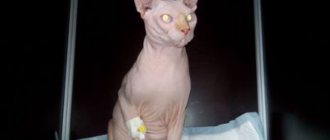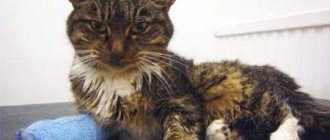Diabetes mellitus in cats is one of the most common diseases of the hormonal system, which is based on a violation of carbohydrate metabolism. The pathology mainly occurs in older animals, more often in neutered cats than in cats. In this article we will talk about why diabetes occurs in cats, why it is dangerous, and how to treat it.
What is diabetes mellitus?
Diabetes mellitus is a condition in which there are high levels of sugar (glucose) in the blood. Insulin is produced in the pancreas and is the hormone responsible for maintaining proper blood glucose levels. Therefore, high blood glucose levels are caused by decreased insulin production and/or the body not responding properly to the insulin produced.
Approximately 1 in 200 cats suffers from diabetes. Cats commonly develop type 2 diabetes. The disease is caused by a combination of the body's inadequate response to insulin and the depletion of the cells that produce insulin. Due to a lack of insulin, the body's cells cannot use the sugar (glucose) needed to produce energy.
Clinical picture
The symptoms of diabetes mellitus depend on the type of disease. The insulin-dependent form has a pronounced clinical picture. A characteristic symptom is severe thirst due to increased glucose concentrations.
The urinary system cannot cope with the load, so its volume increases. Along with polydipsia (unquenchable thirst), dehydration occurs.
Other symptoms:
- Polyuria. Urine discharge is frequent and painful.
- Increased or lack of appetite.
- Weight loss.
- Change in the appearance of the coat. It loses its shine, fades and looks untidy.
- Tachycardia.
- Diarrhea, vomiting.
- Pungent odor of acetone from urine and skin.
- Lethargy, apathy.
- Loss of coordination.
In severe cases, loss of consciousness and convulsions are noted. The further the disease develops, the worse the animal looks: ulcers appear on the skin, hair falls out, and fatty liver develops.
The second type of diabetes mellitus is characterized by the absence of the smell of acetone, painless but frequent urination, and increased appetite. The cat is losing weight, drinking a lot, but his condition is satisfactory.
Glucose in a cat with diabetes
Cats develop diabetes when they do not respond adequately to insulin and/or the pancreas does not produce enough insulin. This means that glucose cannot leave the blood, enter the body's cells and be used as the main source of energy. The cat's body begins to break down muscle and fat as alternative sources of energy. This causes the cat to eat more, but its body weight decreases. At the same time, blood glucose levels rise because it is unable to leave the bloodstream and enter the body's cells.
Common symptoms found in cats
- Increased thirst
- Frequent urination
- Increased feed intake
- Weight loss
- Marked lethargy
- Weakness
If left untreated, diabetes can lead to serious metabolic problems (diabetic ketoacidosis), which can lead to coma or death.
Diabetes mellitus is a polygenic disease in cats that causes the body's inability to regulate glucose metabolism.
The pancreas is a mixed secretion gland, a small organ located next to the stomach, made up of two different types of cells that have very different functions. One group of cells produces enzymes necessary for proper digestion. The other group is beta cells, they produce the hormone insulin, which regulates the level of glucose (sugar) in the blood and controls its delivery to body tissues. But cats with newly diagnosed diabetes did not have antibodies to beta cells and insulin, which is typical for diabetes mellitus in dogs and type 1 diabetes mellitus in humans.
What happens normally?
All cells in our body require glucose (“sugar”) as their main source of energy. Glucose enters the body through the intestines from food or from internal reserves (liver glycogen, muscles, etc.). After eating, glucose from the intestines or from internal reserves enters the blood and its level in the blood increases. The pancreas senses this increase and releases insulin into the blood. The cells of the body perceive the insulin signal and transfer glucose from the blood into the cytoplasm (inside the cells). The level of glucose in the blood drops, the cells feel “full”, and the pancreas stops releasing insulin into the blood. Insulin is a hormone that is produced in the islets of Langerhans in the pancreas.
Pathogenesis of diabetes mellitus in cats.
Diabetes mellitus in cats is classified into three types:
Type 1 – insulin-dependent diabetes mellitus (IDDM) – the pancreas loses its ability to produce enough insulin. Very rare.
Type 2 - non-insulin-dependent diabetes mellitus (NIDDM) - the body's cells lose the ability to perceive the insulin signal. The development is associated with two mechanisms: a violation of the functional state of beta cells of the pancreas, causing a disruption in the synthesis and release of insulin and aniline (it is a precursor of amyloid protein, produced by beta cells and regulates the secretion and release of insulin). Insulin resistance occurs, which leads to impaired utilization of nutrients in tissues sensitive to it. The consequence of these factors is the deposition of amyloid protein in the islets of Langerhans (the development mechanism is similar to type 2 diabetes in humans).
Type 3 - secondary diabetes - develops as a result of various factors, such as pancreatitis or triaditis in cats, hyperadrenocorticism, administration of corticosteroids, acromegaly, stress, urinary tract infections, hyperthyroidism.
Clinical signs.
· Polyuria – more than 20 ml/kg/day.
· Polydipsia – more than 70 ml/kg/day.
When there is a lot of glucose in the urine, it then “pulls” water from the blood. As a result, the volume of urine increases and the animal begins to urinate a lot. Water is removed from the body, the body becomes dehydrated, the animal feels thirsty and begins to drink more. Hence two other symptoms of diabetes: polyuria and polydipsia (excessive drinking and urination).
· Glucosuria - normally the kidneys do not pass glucose from the blood into the urine. However, when blood glucose levels rise above a certain limit, the kidneys cannot cope and glucose begins to be excreted in the urine. Thus, another symptom of diabetes mellitus appears - high glucose in the urine.
· Weight loss, despite a good appetite (polyphagia) – since the cells cannot take glucose inside, the cells in the body begin to starve. The animal itself begins to starve, begins to eat a lot, and also uses internal energy reserves. When glycogen stores in the liver and muscles are no longer sufficient, the body begins to use protein and fat reserves. Due to protein breakdown, muscle mass decreases.
· Plantigrade posture is a sign of diabetic polyneuropathy in cats - that is, when walking, the hock joints rest on the ground.
· Diabetic ketoacidosis - with the massive breakdown of fats in the body, many ketone bodies are formed. Ketone bodies can also be found in urine. One of the ketone bodies is acetone, so animals that are seriously ill with diabetes may smell acetone in their breath. In addition, the acidity of the blood increases (pH decreases). Without intensive treatment, the animal quickly dies.
Hyperosmolar coma
Diagnostics.
1. Biochemical blood test - hypercholesterolemia, increased liver transaminases, a slight increase in creatinine and urea.
2. Measuring blood glucose levels (the optimal sites for collection are the ears and paw pads) - persistent fasting hyperglycemia (more than 10 mmol/liter) along with glycosuria.
Treatment.
The goal of treatment is to achieve acceptable glucose concentrations - 4 (6) - 14 (maximum 18) mmol/liter.
Lantus dosing starts at 0.5 U per kg of cat weight, but not more than 2 U during the first administration. You should start using Levemir in lower dosages: from 0.1 – 0.2 U per kg.
Pet owners must learn to use insulin syringes, distinguish between 100 and 40 unit insulin syringes, and select only those that are suitable for the insulin being injected. In particular, only syringes with a U 100 capacity are suitable for Lantus and Levemir. This means that 1 ml contains 100 active units of insulin action. Insulin dosage is never carried out in ml, only in units of active action!
Initiating intensive monitoring of a diabetic cat should aim to restore its pancreas and achieve remission, meaning that as beta cells recover, the need for exogenous administration will decrease and the insulin dose will need to be lowered. Because of this, owners may experience episodes of hypoglycemia and must be able to recognize them and respond appropriately. If the pet owner does not confuse the insulin dose and the cat eats adequately, then episodes of severe hypoglycemia when using peakless insulins are extremely rare. But it is important to explain to the owner of a diabetic patient that if his pet behaves inappropriately (too active or, on the contrary, passive, he has an increased appetite or impaired reaction, he staggers or does not respond to stimuli), the first step is to measure the sugar and make sure that the animal does not have hypoglycemia.
If the glucose level drops below 4 mmol/l, it is necessary to urgently feed the animal and repeat the glucose measurement after 30 minutes. If the glucose level is below 3 mmol/l and the cat has clinical signs of hypoglycemia, then you should immediately lubricate the gums with honey or glucose syrup (while the animal is swallowing) and immediately bring it to the clinic to show a doctor.
Provided that the cat does not have clinical signs of hypoglycemia and the medical glucometer shows less than 2 mmol/l, this may be due to the different distribution of glucose in humans and animals. In humans, the glucose content of red blood cells is 42%, while 58% of glucose is in plasma.
In cats (fewer red blood cells, which are small in size), the glucose content in red blood cells is about 7%, and 93% of glucose is in the blood plasma, so a medical glucometer shows a lower value than it actually is.
If the cat has no clinical signs of hypoglycemia and the veterinary glucometer shows a glucose level of less than 2 mmol, it is important to ensure that the capillary of the test strip is completely filled with blood. Incomplete filling of the capillary due to a small drop may lead to an underestimate of the result. In this case, the glucose measurement should be repeated.
If the same dose of insulin begins to work longer over time and reduces glucose levels below 4 mmol/l, then this is one of the signs of approaching remission. It is important not to miss it and to reduce the dose all the time, increasing the interval.
If glucose is measured only once a day before insulin administration, it is possible to miss an episode of post-hypoglycemic hyperglycemia, and increase the dose when it needs to be reduced. In this case, a chronic increase in dose can lead to the development of insulin resistance - Somogyi syndrome. Characteristic clinical signs of Somogyi syndrome are persistent hyperglycemia with indicators of uncompensated diabetes mellitus on the background of insulin therapy, persistent polydipsia, polyuria, polyphagia and lack of weight loss. It is very important to identify this condition promptly (by serially measuring glucose levels every 4 hours) and select the correct dose of insulin.
.Use of oral hypoglycemic agents.
In cats with uncomplicated diabetes, hypoglycemic agents (i.e., sulfonylureas) are used to control hyperglycemia. These drugs have several antidiabetic effects, including a strong stimulation of insulin secretion by beta cells, a sustained increase in carbohydrate transport in muscle and fat tissue, a direct effect on the liver to cause a decrease in glucose production, and an increase in the action of insulin on the liver.
Glipizide is usually used. It is administered orally at a dose of 0.25–0.5 mg/kg every 12 hours, up to 5 mg/cat every 8–12 hours. Side effects in cats include vomiting, anorexia and hepatopathy. The effectiveness of treatment should be assessed by measuring the level of glucose and ketones in the urine, as well as by measuring the concentration of glucose in the blood on an empty stomach and 2 hours after feeding. If hypoglycemia or normoglycemia develops, the use of glipizide is discontinued.
Diabetes mellitus in dogs.
There are 4 types of diabetes:
Type 1 - insulin-dependent type - type 1 diabetes mellitus is based on a deficiency (lack of insulin). It occurs much more often, mainly in young individuals, and is similar to the mechanism of type 1 diabetes in humans. Under the influence of etiological factors, beta cells die due to the aggressive influence of the patient’s own antibodies. Insulin does not allow glucose to enter the cell. Therefore, the blood glucose level is high, and the tissues experience severe hunger.
Type 2 - insulin-independent type - insulin resistance and β-cell dysfunction. Occurs rarely, mainly in overweight animals over 7 years of age.
Secondary diabetes mellitus can be a consequence of another disease: pancreatitis, hyperadrenocorticism, or long-term use of medications such as glucocorticoids and progestogens. If the disease is caught early and the cause of hyperglycemia is eliminated before the β cells are destroyed, a complete cure of the animal is possible.
Gestational type of diabetes mellitus - occurs in bitches in the second half of pregnancy or during diestrus due to the high content of progesterone, growth hormone and some other hormones that can cause disruption of tissue sensitivity to glucose. Timely ovariohysterectomy (before β-cell depletion) may promote recovery. However, the animal remains predisposed to developing diabetes in the future.
Clinical signs of diabetes mellitus in dogs.
Polyuria
Polydipsia
Polyphagia
Weight loss
Exercise intolerance/reduced activity
· Ketone mouth odor
Recurrent urinary tract infections, conjunctivitis
Cataract
Hepatomegaly (liver lipidosis)
Diagnostics.
Diagnostics of diabetes is based on the detection of persistent fasting hyperglycemia (more than 10 mmol/l) along with glucosuria, increased blood cholesterol, increased triglycerides and hepatic transaminases (ALT), increased alkaline phosphatase,
Treatment.
Use of oral hypoglycemic (sulfonylurea) agents in dogs. They are PROVEN not effective!
The starting dosage of long-acting insulin is 0.25-0.5 units per 1 kg of weight 2 times a day. It is permissible to adjust the insulin dose no more than once every 2-3 days (5-7 days). Measure blood glucose levels every 2-4 hours (depending on the insulin chosen to stabilize the animal).
Types of insulins, their duration of action
| Insulin drug | Start of action | Peak action | Maximum duration of action |
| Short-acting: Actrapid, Humulin Regular, Insuman Rapid | 30 min | 1-3 hours | 6-8 hours |
| Rapid-acting insulin analogues: Novorapid, Epidra, Humalog | 10-20 min | 1-3 hours | 3-5 hours |
| Long-acting: Protafan, Humulin NPH, Insuman Bazal | 1-2 hours | 4-12 hours | 18-24 hours |
| Ready-made mixtures 30/70: Mixtard 30/70, Humulin MZ | 0.5-1 hour | 5-9 hours | 18-24 hours |
| Ready-made insulin analogues | 10-20 min | 4-12 hours | 18-24 hours |
| mixed: NovoMix30 | |||
| Long-acting insulin analogues: Lantus | 1-2 hours | peakless | up to 24 hours |
| Levemir | 1-2 hours | peakless | 16-24 hours |
Why is high blood glucose a problem?
When blood glucose levels are high, glucose levels in the urine will also increase. This leads to increased urine production and, as a result, increased thirst in the animal. Long-term high blood glucose levels (glucose toxicity) can damage pancreatic cells, which can lead to decreased insulin production. Very high blood glucose levels can lead to serious complications such as diabetic ketoacidosis (DKA), a condition that occurs when a cat's body needs to break down fat as an energy source. Cats with high blood glucose levels over a long period of time can be susceptible to damage to other parts of the body, such as the eyes, nerves, and kidneys.
Possible complications
The pathology is dangerous with severe complications. Elevated glucose concentrations have a detrimental effect on health. Among the most common consequences that diabetes leads to is, first of all, ketoacidosis, which can result in the death of a four-legged pet.
Infusion and insulin therapy can save him, but you need to act quickly. Other complications include diabetic neuropathy, hypoglycemia, hypokalemia, which also often lead to death.
How is diabetes diagnosed?
All signs of diabetes can also be found in other diseases, so your veterinarian will need to do more than just examining your cat. To diagnose diabetes, your veterinarian will need to perform blood tests and often a urine test. Cats with diabetes show several changes:
- High blood glucose levels
- High blood fructosamine levels (a marker that indicates blood glucose levels over the previous 2 weeks)
- Glucose in urine
Your veterinarian may also perform some other blood tests to check if there are any underlying conditions that may affect the treatment plan.
Treatment control
To achieve an improvement in the animal’s well-being, you need to regularly monitor the treatment process:
- Monitoring urine and blood tests. These indicators will help the veterinarian adjust the dosage of drugs.
- A good practice is to keep an observation diary, where the owner enters data about the insulin used. The diary must record information about the time of administration and dose of insulin, the amount of food and water consumed, and changes in the pet’s weight.
- Monitoring urine sugar levels at home. You can check the amount of sugar in your urine using test strips that are sold at pharmacies. The required amount of sugar in the urine should be zero, that is, the urine should not contain glucose.
- Monitoring blood sugar. The normal amount of sugar in pets is 6 mmol per liter. You can use a glucometer to perform this test. It is also possible to monitor blood sugar levels using test strips.
How to collect a urine test from a cat
Why is a urine test needed to determine the disease? With its help, you can adjust the dose of insulin and check the effectiveness of the drug on the body. Many cat owners are perplexed about how to collect a urine test from their pets. For the test to be correct, a morning or night dose of urine is suitable. Here are some tips:
- It is convenient to collect urine when the pet goes into a tray without sand, with a grid that will help in this matter.
- It is also proposed in this case to use not sand in the tray, but sterilized gravel that does not absorb moisture. Urine will run through it to the bottom of the tray. All that remains is to collect it in a container.
- In extreme cases, in a clinical setting it is possible to collect urine using a catheter. It is often not recommended to use this method, because it can injure the animal’s ureter.
How to take a blood sugar test correctly
A cat suffering from diabetes needs to have blood taken daily for insulin. This is a very important procedure, since the animal may experience stress at this moment, and therefore insulin will not show the correct results. When treatment has just begun, to find out whether insulin is having the proper effect on the body, a blood test will have to be taken every 1.5 hours. The quality of the analysis is affected by the time and amount of food eaten.
- It is best to take a blood test from the ear, in the middle of which there is a vessel from which it is easy to take a test.
- The blood test should be carried out only using disposable needles, which are included in the kit with the glucometer.
- The glucometer handle with the needle should be placed on the outside of the ear above the vessel. The blood test should be taken only from a warm and dry ear; you can pre-warm it with a dry palm.
- When droplets of blood appear, you need to bring the glucometer with the plate. The blood will be absorbed into the plate.
A cat taking insulin should not feel hungry.
How to treat diabetes?
Although diabetes is a serious condition that often cannot be cured, in most diabetic cats the condition can be successfully controlled with insulin, often in combination with dietary changes. This will reduce high blood glucose levels and allow the body's cells to use glucose as their main source of energy. The overall goal of treatment is to control the clinical signs of diabetes and ensure a good quality of life for the cat.
What to do at home
The owner is required to follow the specialist’s instructions and provide the sick pet with the best possible care. Diabetes is not a death sentence. Even if it is impossible to cure it, it is quite possible to prolong the life of a four-legged pet.
The owner will have to constantly monitor the sugar in the furry’s blood and urine. Most cat owners use special test strips to determine sugar.
Seeing the result, the owner can make the necessary adjustments to the diet and take appropriate measures to reduce this dangerous indicator. Glucometers give more accurate results; as a rule, they are used in severe stages of the disease.
The cat's nutrition is of great importance. The diet is compiled individually. The specialist takes into account the cat’s general condition and sugar levels. The diet must contain protein and fiber. Carbohydrates are allowed, but should not be abused! Meals are fractional, but no more than 6 times.
With this treatment regimen, the pancreas experiences minimal stress, glucose is maintained at an optimal level throughout the day. A specialist, as a rule, recommends certain medicinal feeds for use. The owner needs to understand that a sick pet will have to stick to this diet for the rest of its life.
Ensuring your cat's well-being
For most cats, stabilization can be achieved very easily with lifelong therapy and related measures. You should work with your veterinarian to determine the best insulin dose, ideal diet, and lifestyle adjustments (if necessary) to achieve maximum control. Make sure you give your cat the correct dose of insulin on schedule. Maintain a regular feeding schedule and offer your pet the amount of food recommended by your veterinarian. Do not give your cat medications, including vitamins or nutritional supplements, without first consulting your veterinarian.
Diagnostics
Diabetes mellitus cannot be diagnosed based on symptoms alone, as they can be common to different diseases. The doctor may prescribe a variety of tests, here are some of them :
- general blood analysis;
- Ultrasound;
- blood chemistry;
- urine test.
In some cases, diagnosis includes a glucose tolerance test. Express urine testing using special sugar-sensitive strips is often used.
What is the outlook for my diabetic cat?
The long-term outlook for cats with diabetes varies depending on their age, how easy it is to stabilize their diabetes, whether they have any other medical conditions, and how severe they are. Most cats with diabetes have an excellent quality of life, and many can live very comfortably with diabetes if the disease is properly controlled. Unfortunately, not every cat responds well to therapy. Your veterinarian will need regular exams to evaluate your cat's response to treatment, and if your cat's condition is difficult to stabilize, becomes unstable, or appears to require very large doses of insulin, additional tests may be needed to look for other underlying conditions. If you are concerned about your cat's condition, take her to a veterinarian.
What you need to know about the disease
Feline diabetes is a disease similar to humans. It has similar causes and clinical picture.
Why diabetes is dangerous
Without timely treatment, the disease leads to sudden weight loss, dehydration, problems with motor function, coma and death. The danger of the pathology is that it is detected late. By the time cats are diagnosed, they are usually already severely insulin dependent.
Risk group
Animals suffering from obesity and inflammation of the pancreas are at particular risk. There is no clearly defined age category for cats with diabetes. Although it has been noted that most often the disease occurs in middle-aged and elderly pets. The disease is more common in cats than in cats.


